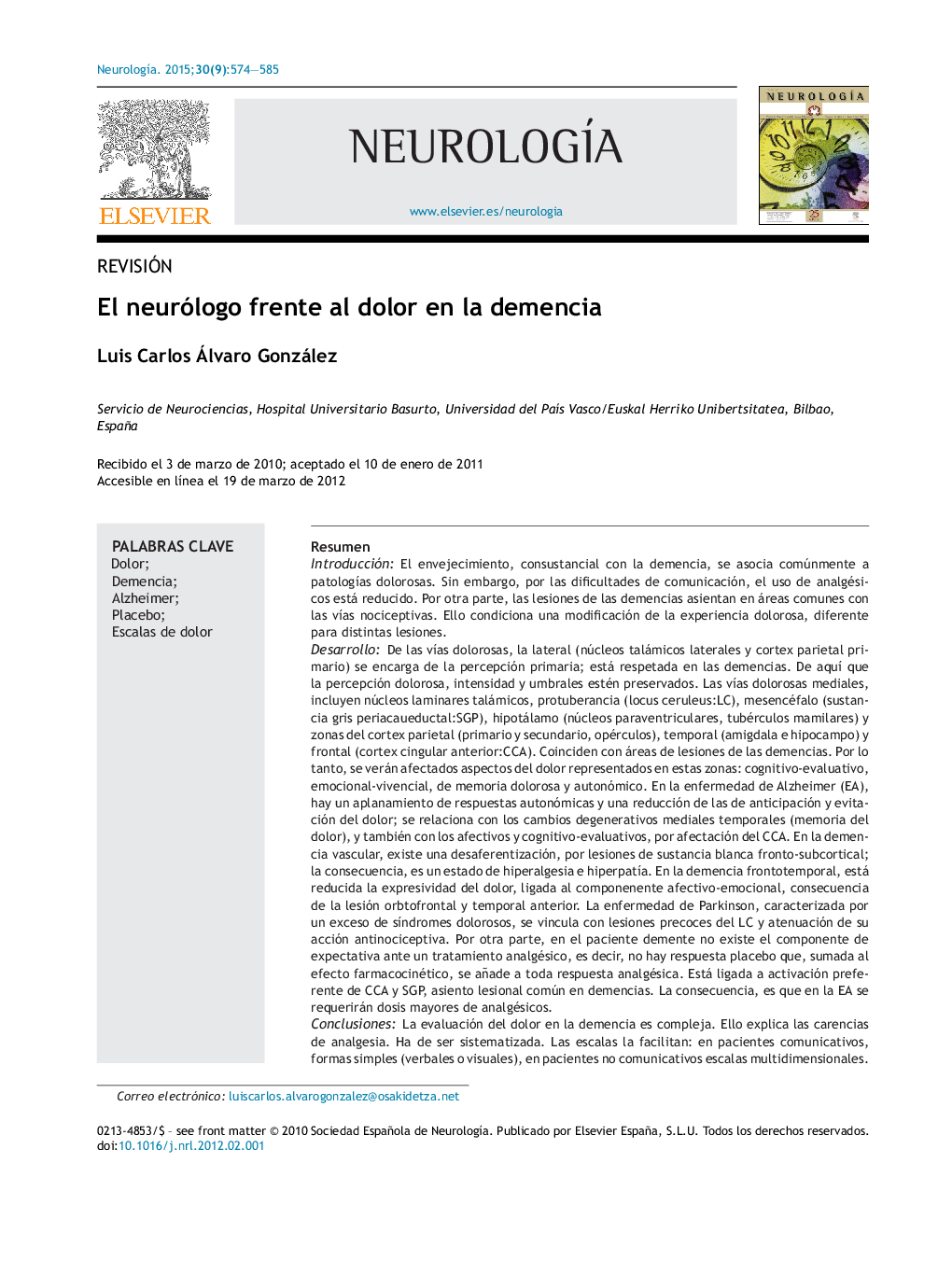| کد مقاله | کد نشریه | سال انتشار | مقاله انگلیسی | نسخه تمام متن |
|---|---|---|---|---|
| 3075719 | 1580974 | 2015 | 12 صفحه PDF | دانلود رایگان |

ResumenIntroducciónEl envejecimiento, consustancial con la demencia, se asocia comúnmente a patologías dolorosas. Sin embargo, por las dificultades de comunicación, el uso de analgésicos está reducido. Por otra parte, las lesiones de las demencias asientan en áreas comunes con las vías nociceptivas. Ello condiciona una modificación de la experiencia dolorosa, diferente para distintas lesiones.DesarrolloDe las vías dolorosas, la lateral (núcleos talámicos laterales y cortex parietal primario) se encarga de la percepción primaria; está respetada en las demencias. De aquí que la percepción dolorosa, intensidad y umbrales estén preservados. Las vías dolorosas mediales, incluyen núcleos laminares talámicos, protuberancia (locus ceruleus:LC), mesencéfalo (sustancia gris periacaueductal:SGP), hipotálamo (núcleos paraventriculares, tubérculos mamilares) y zonas del cortex parietal (primario y secundario, opérculos), temporal (amigdala e hipocampo) y frontal (cortex cingular anterior:CCA). Coinciden con áreas de lesiones de las demencias. Por lo tanto, se verán afectados aspectos del dolor representados en estas zonas: cognitivo-evaluativo, emocional-vivencial, de memoria dolorosa y autonómico. En la enfermedad de Alzheimer (EA), hay un aplanamiento de respuestas autonómicas y una reducción de las de anticipación y evitación del dolor; se relaciona con los cambios degenerativos mediales temporales (memoria del dolor), y también con los afectivos y cognitivo-evaluativos, por afectación del CCA. En la demencia vascular, existe una desaferentización, por lesiones de sustancia blanca fronto-subcortical; la consecuencia, es un estado de hiperalgesia e hiperpatía. En la demencia frontotemporal, está reducida la expresividad del dolor, ligada al componenente afectivo-emocional, consecuencia de la lesión orbtofrontal y temporal anterior. La enfermedad de Parkinson, caracterizada por un exceso de síndromes dolorosos, se vincula con lesiones precoces del LC y atenuación de su acción antinociceptiva. Por otra parte, en el paciente demente no existe el componente de expectativa ante un tratamiento analgésico, es decir, no hay respuesta placebo que, sumada al efecto farmacocinético, se añade a toda respuesta analgésica. Está ligada a activación preferente de CCA y SGP, asiento lesional común en demencias. La consecuencia, es que en la EA se requerirán dosis mayores de analgésicos.ConclusionesLa evaluación del dolor en la demencia es compleja. Ello explica las carencias de analgesia. Ha de ser sistematizada. Las escalas la facilitan: en pacientes comunicativos, formas simples (verbales o visuales), en pacientes no comunicativos escalas multidimensionales. Examinan aspectos expresivos, motores, emocionales, funcionales y de interacción social. El dolor puede condicionar un deterioro o progresividad de la demencia. Es una causa tratable y reversible, por lo que no debe dudarse en iniciar tratamiento analgésico si se sospecha. Será intensivo y cuidadoso, para minimizar el alto riesgo de efectos secundarios.
IntroductionAgeing, a common background in dementia, is usually associated with painful disorders. Nevertheless, the use of analgesics is limited due to poor communication. On the other hand, dementia lesions are placed in the nociceptive pathways. For this reason, the painful experience becomes different and distinctive for every lesional type.CourseThe lateral nociceptive pathway (lateral thalamic nuclei and primary parietal cortex), which is in charge of the primary pain perception, is preserved in dementia. Thereafter, the shear painful perception, including pain intensity and threshold, remains unmodified. Distinctly, the medial pain pathways are affected by dementia lesions. In this pathway are included: the intralaminar thalamic nuclei, the pons (locus ceruleus:LC), the mesencephalon (periaacueductal grey substance: PGS), the hypothalamus (paraventricular nuclei, mamilary tuberculum) and different areas of the parietal (primary, secondary, operculum), temporal (amigdala, hypoccampus) and frontal (anterior cingular: ACC). As a consequence, the features of pain executed by these areas will be compromised: the cognitive assessment, the mood and emotion inherent to pain, the pain memory or the autonomic responses are modified in dementia. Specifically, in Alzheimer's disease (AD) there is a reduction in the anticipatory and avoidance responses and also a flattening of the autonomic responses. These are essentially secondary to the degenerative changes in the medial temporal (pain memory) and ACC (cognitive and mood aspects) areas. In vascular dementias, there is a cortico-subcortical deafferentation secondary to the white matter lesions. The consequence is the presence of hyperpathy and hyperalgesia. In the frontotemporal dementias, there is a reduction in pain expressivity. It is linked to the lesions in the orbitofrontal and anterior temporal areas, which are responsible of the emotional aspects of pain. In Parkinson's disease, painful conditions are a common characteristic. They are attributed to an early lesion in the LC, which reduces its prominent antinociceptive activity. Finally, in the demented patients there is a lack of expectations to analgesic treatments. This means an absence of the placebo effect, which is, alongside the pharmacokinetic action, an inherent part of the analgesic response. The placebo response is related to activity in the ACC and PGS. Giving its lack, higher doses of analgesics are necessary in dementias.ConclusionsThe assessment of pain in dementia is rather complex, which is the main reason for the scarcity of the analgesic treatment in dementias. It must be specific and systematic. For this purpose, the pain scales are a useful tool. For communicative patients, simple visual scales are helpful, meanwhile in the non-communicative patients the multidimensional scales are the most suitable. By this means, the expressive, motor, emotional, functional and social interactions are evaluated. Pain may be responsible of progression and cognitive deterioration in dementia. This evolution could be reversible, and consequently it has to be foreseen in order to implement analgesic treatment. Trying to minimize adverse events, it has to be potent but closely monitored.
Journal: Neurología - Volume 30, Issue 9, November–December 2015, Pages 574–585